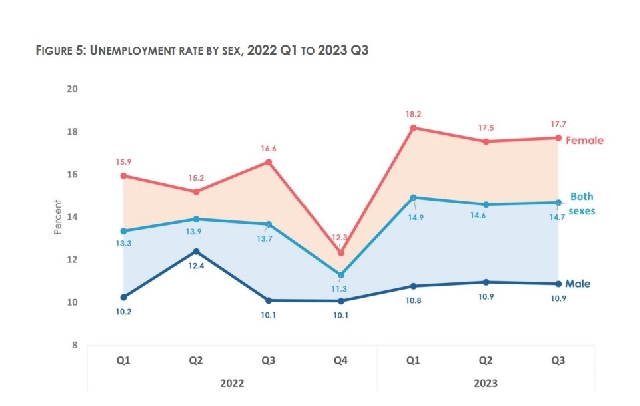Youth unemployment up 14% – GSS
 Unemployed youth
Unemployed youth
The average unemployment rate in the country has soared to 14.7 percent in the first three quarters of 2023, according to data obtained from the Annual Household Income and Expenditure Survey Quarter Three Labour Bulletin by the Ghana Statistical Service (GSS).
Disturbingly, the number of unemployed youth aged between 15 and 35 increased from approximately 1.2 million to over 1.3 million during the same period, with a consistently higher rate among females than males.
The survey further indicated that the number of youth without jobs in 2022 only saw a dip in the second quarter of last year.
The sharp increase in the unemployment rate of females between the fourth quarter of 2022 and the first quarter of 2023 has culminated in a wider unemployment gender gap in 2023 relative to 2022.
About 440,000 persons joined the labour force between 2023 Q1 and 2023 Q3, of which more than 60.0 per cent were employed during the period. Consistently, more females than males have been employed, with the difference averaging about 600,000 and 900,000 for 2022 and 2023 respectively.

The number of employed persons in urban areas remained nearly the same in the first three quarters of 2023 after quarterly variations in 2022.
The number of employed persons in rural areas increased for five consecutive quarters from 2022 Q2, before declining in the third quarter of 2023.
The difference in the unemployment rates between urban and rural areas widened successively for the first three quarters of 2023.
In the second and third quarters of 2023, the urban unemployment rate was almost twice compared to rural areas. The average unemployment rate for the first three quarters of 2023 was 14.7 percent, with the rate among females consistently higher than males.
The sharp increase in unemployment rate of females between the fourth quarter of 2022 and the first quarter of 2023 has culminated in a wider unemployment gender gap in 2023 relative to 2022.
The labour force participation rate increased significantly between the fourth quarter of 2022 and the first quarter of 2023 but remained stable across the first three quarters of 2023.
Consistently, the ability of the labour market to absorb or accommodate individuals seeking employment (absorption rate) increased from the second quarter of 2022 to the third quarter of 2023.

Source: classfmonline.com/Zita Okwang
Trending News

Jospong Group partners with Ghanaian scholars in diaspora to boost Ghana’s growth
16:22
Police foil highway robbery, gun down 3 suspects, retrieve 7 weapons
17:38
Ama Mawusi Foundation donates 600 food packs to street children in Greater Accra
16:11
Nation-first, principled and people-centred leadership wins us elections, and Bawumia stands for it – Akosua Manu to NPP
11:57
Jospong Group Chairman spreads New Year cheers with food, cash gifts for over 5,000 Ghanaians
16:06
MP raises insurance, public safety concerns after DVLA suspends new number plate system
11:52
Ghana to discover oil in Northern, Central and Volta Regions - Prophet Stephen Ask-Ackrong reveals
13:40
Bawumia doesn't want a single drop of blood to be shed on account of his personal ambition – Akosua Manu
11:39
Bawa Rock only successful applicant among 31 aggregator bid-Sammy Gyamfi reveals
00:58
Ebo Noah remanded, ordered to undergo psychiatric assessment over doomsday flood prophecy
14:40




